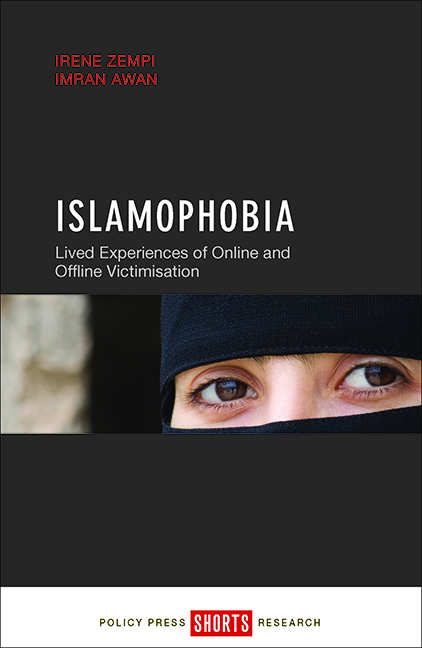Book contents
one - Understanding Islamophobia
Published online by Cambridge University Press: 05 April 2022
Summary
The term Islamophobia has come under increasing scrutiny after the rise in Islamophobic hate crimes post 9/11 and more recently following the Paris attacks in 2015. Both these incidents have led to a rise in Islamophobic hostility, and reported hate crimes committed against Muslim communities have increased (Littler and Feldman, 2015). As a result, Islamophobia has become an important and emerging concept, and it relates to wider issues around the racialisation and the ‘othering’ of Muslim communities. However, whilst there is no universal interpretation or definition of Islamophobia, the debate about what the term means is often stoked up by people's fears about Muslims. For example, increasingly the term ‘Islamophobic hate crime’ is used within the context of Muslims suffering a form of hate crime. Despite these debates in the United Kingdom (UK), it is acknowledged that hate crime is not always motivated by hate; rather, it can be motivated because of hostility or prejudice towards a person's disability, race or ethnicity, religion or belief, sexual orientation or transgender identity. This chapter focuses on the concepts and terminology surrounding Islamophobia and hate crime, and argues that contemporary Islamophobia is a reflection of a historical Islamophobic phenomenon which was constructed in colonial times, but which has increased significantly in recent times, creating a deeper resentment, hostility and fear of Islam and of Muslims than existed before.
Constructing the debate on Islamophobia
The Runnymede Trust described Islamophobia as unfounded hostility towards Muslims which results in fear and dislike of Muslims. The seminal Runnymede Trust report (1997) identified eight components of Islamophobia. They include where people view:
1. Islam as a faith that is unresponsive to change.
2. Where the values of Islam appear not to be compatible with other cultures and faiths.
Islam is viewed as being a religion that is barbaric and sexist.
4. Islam is also seen as being a religion that is both violent and aggressive.
5. Islam is viewed as a political ideology.
6. Islam and criticisms made about the faith are unwarranted.
7. Discriminatory practices are used to justify exclusion of Muslim communities.
8. Islamophobia is seen as normal.
- Type
- Chapter
- Information
- IslamophobiaLived Experiences of Online and Offline Victimisation, pp. 1 - 14Publisher: Bristol University PressPrint publication year: 2016



